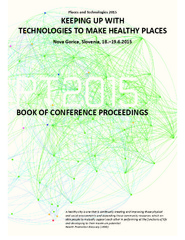| dc.contributor | Fikfak, Alenka | |
| dc.contributor | Vaništa Lazarević, Eva | |
| dc.contributor | Fikfak, Nataša | |
| dc.contributor | Vukmirović, Milena | |
| dc.contributor | Gabrijelčič, Peter | |
| dc.creator | Stupar, Aleksandra | |
| dc.creator | Đukić, Aleksandra | |
| dc.date.accessioned | 2020-05-06T20:22:14Z | |
| dc.date.available | 2020-05-06T20:22:14Z | |
| dc.date.issued | 2015 | |
| dc.identifier.isbn | 978-961-6823-68-5 | |
| dc.identifier.uri | https://raf.arh.bg.ac.rs/handle/123456789/670 | |
| dc.description.abstract | Public spaces represent essential elements of healthy, functional, eco and smart
cities. Being attractive, safe, comfortable, active and inclusive they play the main
role in revitalizing communities, supporting their sense of identity and culture and
triggering their economic development. The process of globalization, facilitated by
the increasing number of ICT networks, imposes a number of new trends which
should be followed by professionals. Their aim is to provide an updated setting for
public life, which nowadays encompasses both private and public realms, material
and virtual reality. Unfortunately, the contemporary lifestyle has caused numerous
mental and physical health problems, including chronic diseases, toxic exposure
and injuries resulting from uncontrolled violence. Therefore, well-conceived and
managed public spaces can influence the health of citizens because their
performances could encourage an intensive use of outdoor facilities. Public spaces
where users feel safe to play and relax can relieve stress, especially when people
live in multi-family apartments or in crowded parts of a city.
Considering all these trends and demands, the role of ICT becomes more important
in the process of design and use of public spaces. This paper will present and
analyse the connection which is established and intensified between users and open
spaces via information networks. The emphasis will be on two main groups of
applications aiming at (1) citizen participation (e.g. ‘crowdsourcing’ or
‘participatory sensing’ applications related to mapping and monitoring of
pollution, health risks and patterns) or (2) individuals' health consciousness (e.g.
applications enabling surveillance of urban spaces and personal life habits). | en |
| dc.language.iso | en | sr |
| dc.publisher | Ljubljana : Faculty of Architecture | sr |
| dc.relation | info:eu-repo/grantAgreement/MESTD/Technological Development (TD or TR)/36035/RS// | |
| dc.relation | info:eu-repo/grantAgreement/MESTD/Integrated and Interdisciplinary Research (IIR or III)/43007/RS// | |
| dc.rights | openAccess | sr |
| dc.source | Keeping up with technologies to make healthy places : book of conference proceedings / [2nd International Academic Conference] Places and Technologies 2015, Nova Gorica, Slovenia | sr |
| dc.subject | Open public spaces | sr |
| dc.subject | ICT | sr |
| dc.subject | Health | sr |
| dc.title | Open public spaces for healthier cities | sr |
| dc.type | conferenceObject | sr |
| dc.rights.license | ARR | sr |
| dcterms.abstract | Ступар, Aлександра; Ђукић, Aлександра; Опен публиц спацес фор хеалтхиер цитиес; Опен публиц спацес фор хеалтхиер цитиес; | |
| dc.citation.spage | 602 | |
| dc.citation.epage | 609 | |
| dc.identifier.fulltext | https://raf.arh.bg.ac.rs/bitstream/id/1795/Book_of_Proceedings_PT2015StuparDjukic.pdf | |
| dc.identifier.rcub | https://hdl.handle.net/21.15107/rcub_raf_670 | |
| dc.type.version | publishedVersion | sr |

